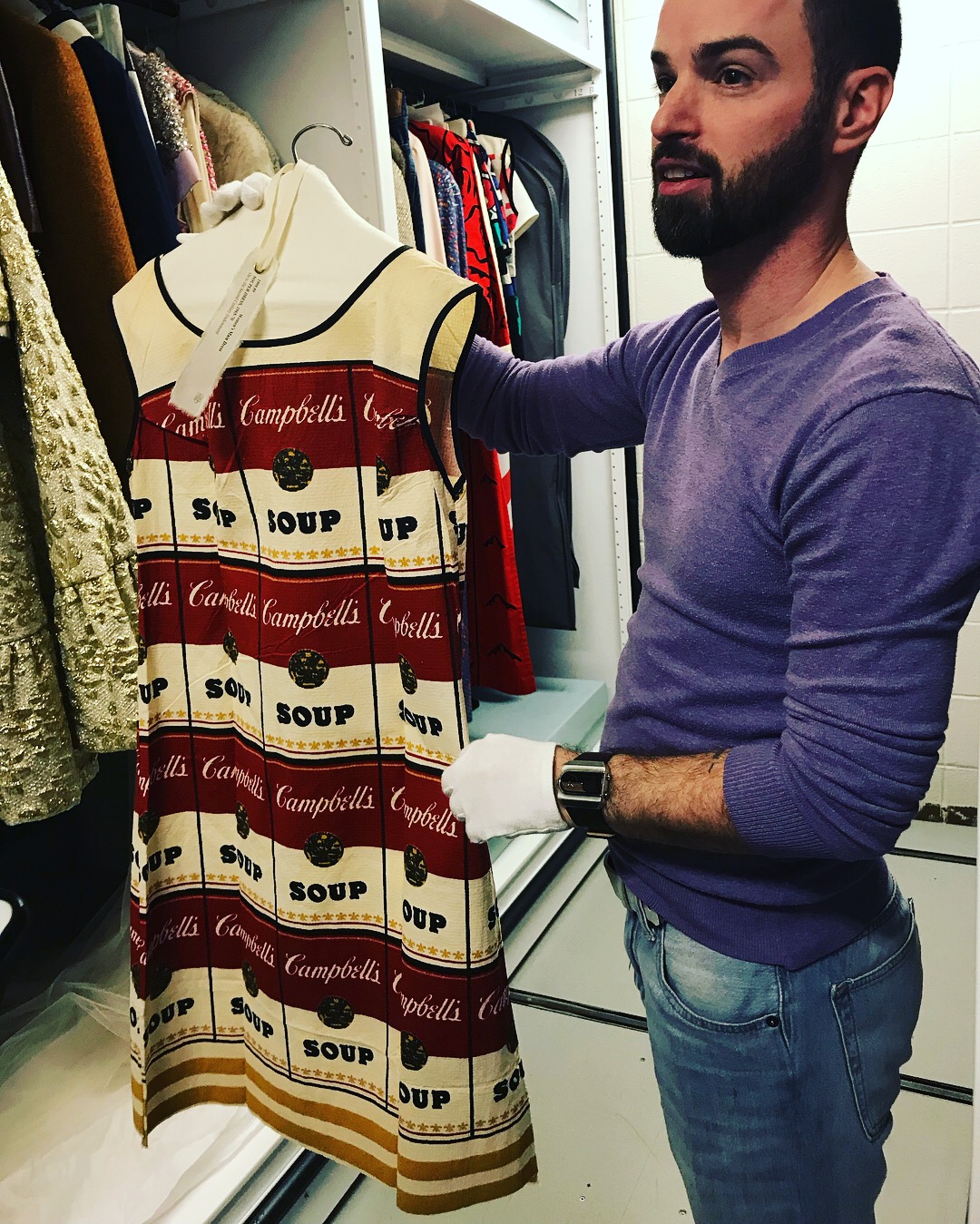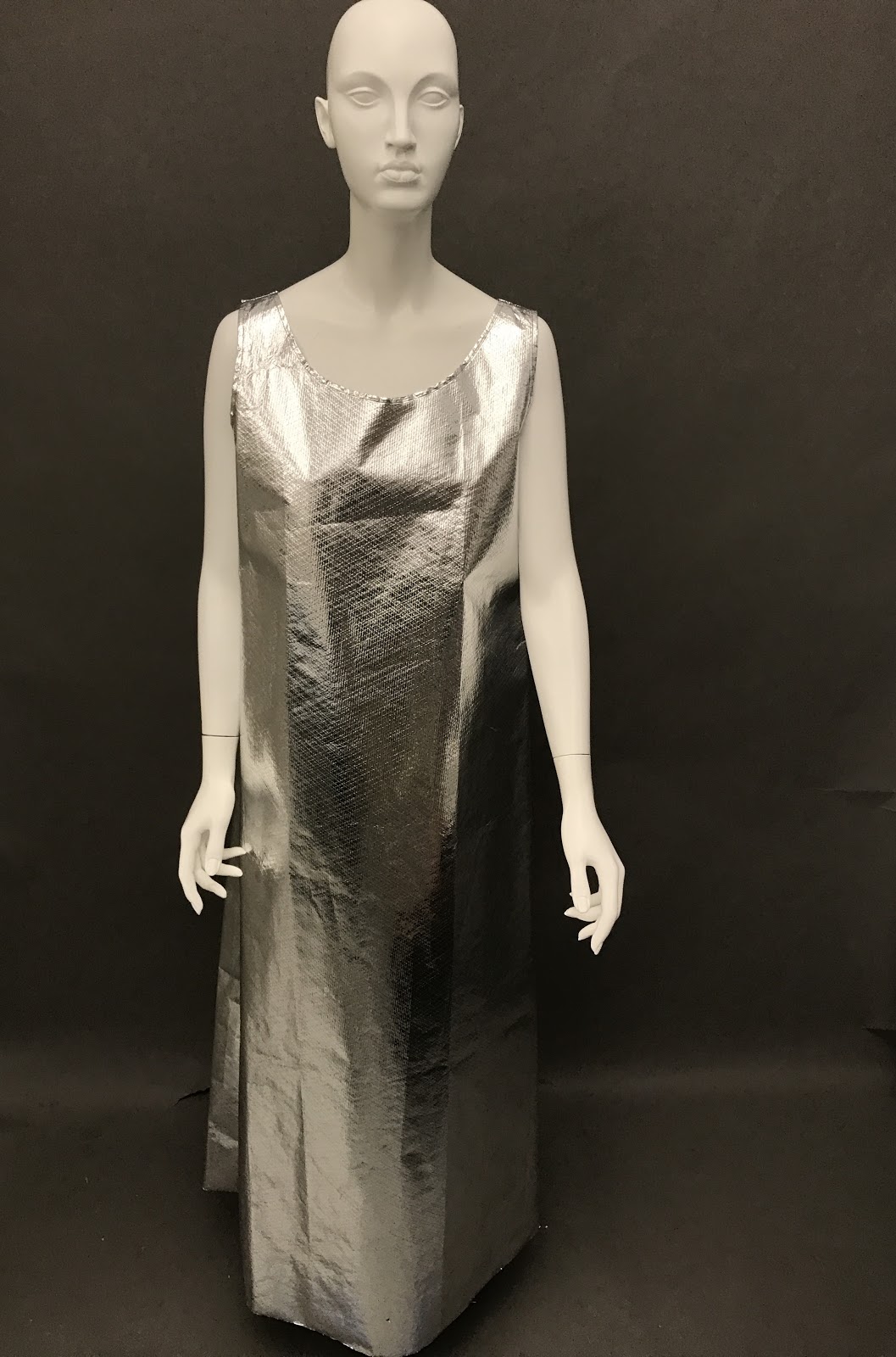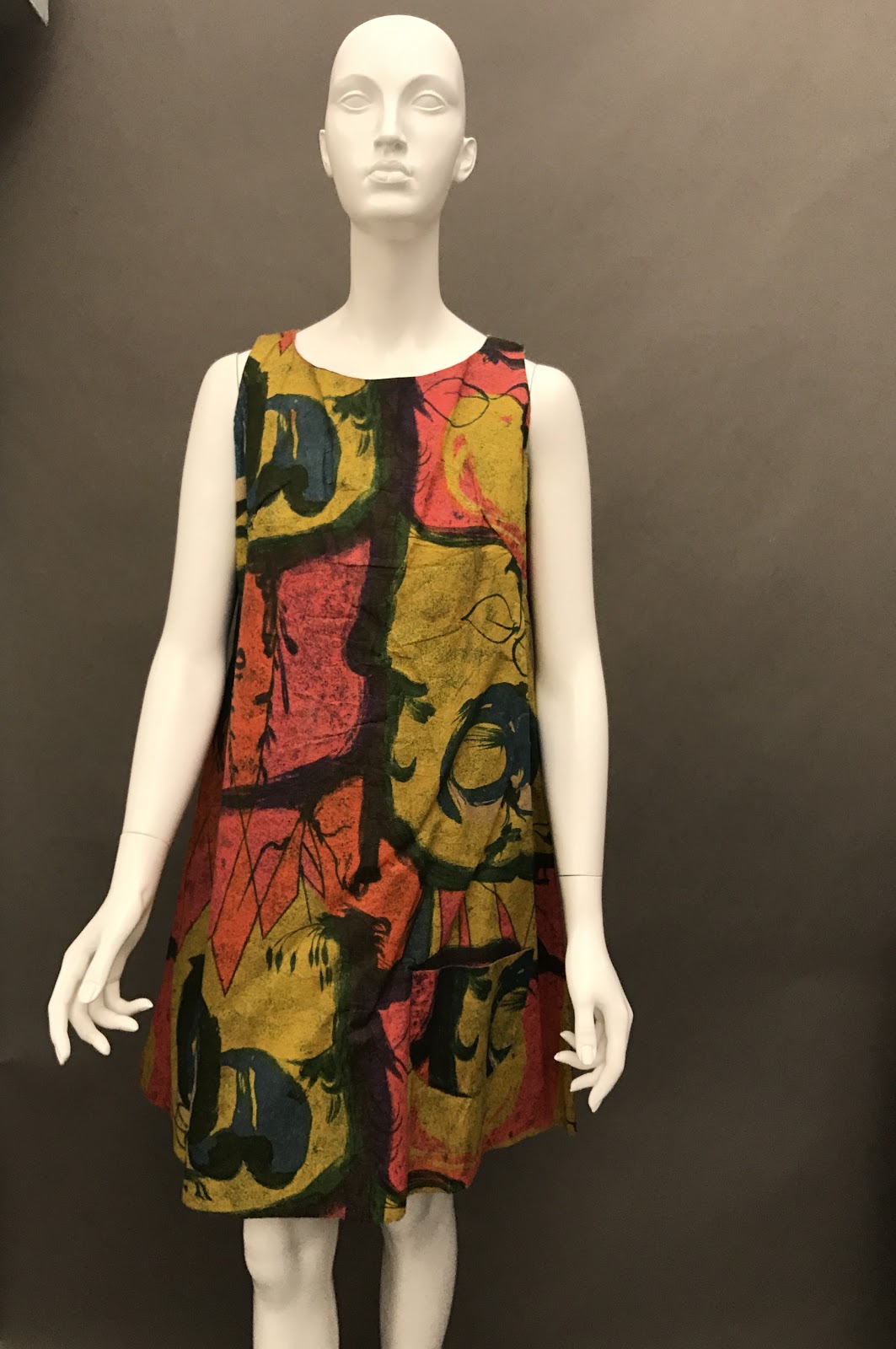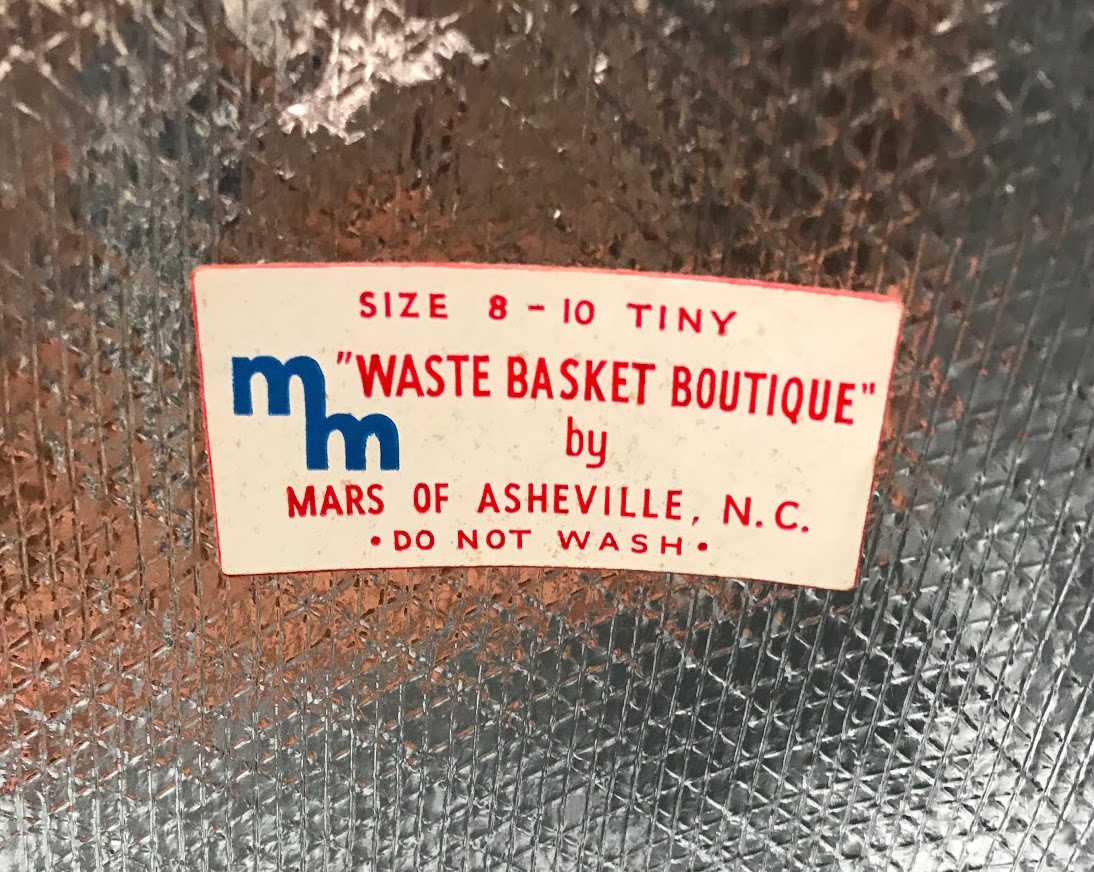Blog post by Livia Caligor ’21

As my fingers skimmed through the funky, pattern-clad dresses hanging from the 1960s aisle in the Cornell Costume and Textile Collection, they suddenly halted when landing upon a rough metallic material. Perplexed by the unexpected texture in a sea of neon, geometric patterns and retro silhouettes, I pulled out a floor-length, aluminum foil gown wrapped in a crinkled plastic coating. This tubular metallic gown was made of metallic plastic that is essentially a disposable crêpe paper. There are darts from the side seam to bust but no other stitches, folds, or hems. There are two loose straps on both the left and the right side of the dress, in both the front and the back, allowing for multiple ways of creating strap ties or bows. The metallic plastic almost appears to have a crocodile-skin texture upon close inspection.
As I stared at this Space Age floor-length paper gown, the labels on the packing were almost as puzzling and abnormal as the garment itself. Splashed across the top of the label, next to a caricature of a figure glistening in the metallic gown, read “NEW! From The… ‘Waste Basket Boutique’ Collection, The Silverfoil Floor Length Dress.” “Mars of Asheville,” the brand, instructed the wearer to press the gown with a cool iron and shorten it with scissors; after all, it is a disposable garment. Perhaps the most uncanny aspect of the packaging is the sizing chart, which reads, “Teeny: 4-6, Tiny: 8-10, Bigger: 12-14, Biggest: 16-18.” A clear indicator of the drastically different beauty standards in the 60s, this sizing chart, along with the the garment’s collection name, markets the dress in an almost comical and entertaining manner. I wondered why this paper fashion line would design and sell a galaxy-inspired plastic garment that was advertised as a product of one’s garbage can scraps.

Upon further research, I discovered that this disposable gown, which was donated by Susan Greene in 2002 after being deaccessioned from the collection at Chemung Historical Society in Elmira, NY, was not an anomaly in 1960s fashion, but a fashion trend. From space-age to maternity, designer styles to those produced by the Campbell’s Soup Company, disposable paper dresses are emblematic of of 1960s fashion and are an early example of fast fashion.

In 1966, Scott Paper Co. invented the paper garment as a promotion gimmick. Mocking a culture that was increasingly accustomed to disposable paper goods, Scott Paper Company employed the paper dress as a tongue-in-cheek marketing tool: women could buy the paper dress for one dollar and receive a variety of coupons for other paper goods. The paper dress came in two designs, one that was a black and white op art print, and the other that was a red bandana print.
The “Mars of Asheville” metallic gown in the CCTC was a continuation of a culture that had grown accustomed to disposable paper goods and utensils. The company marketed their dresses as clothing “created to make you the conversation piece at parties. Smashingly different at dances or perfectly packaged at picnics. Wear it anytime…anywhere. Won’t last forever…who cares? Wear it for kicks — then give it the air.” In eight months after the brand’s genesis, Scott Paper Co. sold half a million dresses, and they abruptly ended their campaign; they did not want to become clothing manufacturers.
With the demand for paper garments continuing to skyrocket, other designers and manufacturers quickly filled the new void in the industry. Mars of Asheville became the most famous producer of paper dresses, selling 80,000 to 100,000 pieces a week. They even began to sell jumpsuits, vests, childrenswear, and — believe it or not — swimwear! These paper products could be worn a handful of times, adjusted with scissors and scotch tape if need be, and tossed in a wastebasket by the time a new fad emerged. Although entitled paper dresses, most were composed of approximately 93% cellulose and 7% nylon or made of “Dura-weave,” which was rayon-reinforced cellulose. Thus, they were durable enough to withstand a few wears. Occasional velcro detailing rendered them even more Space Age-esque in the public eye. They were sold everywhere, from corner stores and pharmacies to boutiques and malls. Consumers would often buy paper goods that matched their garments, and the expediency of their purchase implied a modern and leisurely lifestyle.

Another floor-length silver foil Mars of Asheville gown found in the CCTC’s collection was constructed in a more detailed manner and even contains binding. The crêpe plastic fabric seems to have reinforcement thread running across it, creating a geometric pattern and eye-catching texture. This silver foil gown was perhaps more durable than the first, due to the sturdy binding, which renders the fabric tougher and more difficult to pull. Although this dress did not come in packaging, the tag on the inside conveys similar information as the packaging of the first, warning the wearer from washing the garment.

These two silver dresses are perhaps more funky and avant-garde instances of paper dresses. They were most likely worn on special occasions; in the collection, I also unearthed multiple pret-a-porter paper dresses that were meant for daily wear. One 1968 multicolored paper jumper by Tuscany is especially emblematic of the 1960s paper garment movement. Donated by costume curator and collector Beverley Birks in 2001, this yellow paper dress features an abstract pink, green, and blue foliage print that seems as if it was applied to the paper hastily. The dress also features an oversized pocket on the lower front of the garment. The garment’s arm holes and neckline were hemmed, but the bottom was not. Conforming to the trending 1960s-mod A-line silhouette, the garment was most likely very cost effective to produce. Thus, the funky yet hastily-created print, silhouette, functional pocket, and disposability render this garment an emblem of 1960s paper fashion.
 Many other paper garments from this decade were similar, such as this “Mars of Asheville” blue and aqua printed paper dress. Worn from 1966-1969, it features a long, a-line silhouette, an abstract, expressive print, and adjustable neckties on the back. Similar to the silver one, it is also bound together by reinforcement threads. Although somewhat durable, the garment was clearly no longer in good repair after a few wears. The dress has simple, ripping hemming on the top of the garment, holding the sleeves together, a hand-cut edge, and a square of paper missing from the bottom left side.
Many other paper garments from this decade were similar, such as this “Mars of Asheville” blue and aqua printed paper dress. Worn from 1966-1969, it features a long, a-line silhouette, an abstract, expressive print, and adjustable neckties on the back. Similar to the silver one, it is also bound together by reinforcement threads. Although somewhat durable, the garment was clearly no longer in good repair after a few wears. The dress has simple, ripping hemming on the top of the garment, holding the sleeves together, a hand-cut edge, and a square of paper missing from the bottom left side.
Although the paper garment trend peaked in the late 1960s, when they hit European shores and entered the Beatles’ wardrobe, they were not far cheaper to produce than ordinary clothing. By 1974, this fad had died down; as environmental concerns became a larger topic of discussion, nature and hippie-inspired styles replaced the Mod and Pop styles.

While most paper garments found their way to trash bins by the 1970s, the concept has been reincarnated into a new form today. Not only was Harry Gordon’s 1967 paper Poster Dress featured on a wall of 1960s shift dresses at MoMA’s “Elements: Is Fashion Modern?” (on view through January 28, 2018), paper fashion as a whole has also impacted our society’s current consumer culture. The fast fashion industry’s process of capitalizing upon fads through expedient and exploitative overproduction and our consumer mentality of over consuming disposable goods mimic the structure of the paper garment industry. However, they hold different social and environmental connotations. When I asked Beverley Birks, donor of the Tuscany paper dress, for her thoughts on paper garments in relation to the genesis of fast fashion, she expressed that “Environmentalism didn’t exist as a subject back then. It was just starting. [Paper garments] represented freedom from labor, freedom from making clothes. It was so that you didn’t have to do stuff, iron garments, wash garments…. It was a disposable item. But things change I do remember being told at Cornell that we have to change our way of life, and I think that’s more true today than it was then, and a lot more people are realizing that. The planet can’t take [fast fashion].” While paper fashions of the late 1960s represented liberty, novelty, and experimentation, its contemporary manifestation—fast fashion—takes on a much more dangerous form by threatening the environmental, exploiting human labor, and creating massive amounts of textile waste.

 Livia Caligor is a freshman in Cornell’s Department of Fiber Science and Apparel Design. She is majoring in Fashion Design Management and pursuing a concentration in Management & Marketing with a Business minor. With a profound love for fashion, she has explored various sectors of the industry, including logistical management, design, creative marketing, e-commerce, backstage show management, buying, foreign translation, pre-production, wearable technology research, retail, and academia. She views fashion as a complex and responsive art form that can both reflect and drive political, cultural, and economic changes and enjoys studying fashion history in relation to social justice and societal changes. She is fascinated by the social and environmental impacts of garment production and hopes to delve into socially responsible fashion. At Cornell, she is currently a College of Human Ecology student ambassador, member of the Alumni Relations Committee of Cornell Fashion Industry Network, member of the Logistics and Events Planning Committee of The Cornell Fashion Collective, and an undergraduate research assistant for The Cornell Costume and Textile Collection.
Livia Caligor is a freshman in Cornell’s Department of Fiber Science and Apparel Design. She is majoring in Fashion Design Management and pursuing a concentration in Management & Marketing with a Business minor. With a profound love for fashion, she has explored various sectors of the industry, including logistical management, design, creative marketing, e-commerce, backstage show management, buying, foreign translation, pre-production, wearable technology research, retail, and academia. She views fashion as a complex and responsive art form that can both reflect and drive political, cultural, and economic changes and enjoys studying fashion history in relation to social justice and societal changes. She is fascinated by the social and environmental impacts of garment production and hopes to delve into socially responsible fashion. At Cornell, she is currently a College of Human Ecology student ambassador, member of the Alumni Relations Committee of Cornell Fashion Industry Network, member of the Logistics and Events Planning Committee of The Cornell Fashion Collective, and an undergraduate research assistant for The Cornell Costume and Textile Collection.
Sources:
“Mars of Asheville .” Asheville Art Museum: Latest News and Announcements , Asheville Art Museum , 2015, www.ashevilleart.org/artists/mars-of-asheville/.
GlamourSurf. “The Disposable Paper Dresses of 1967.” GlamourSplash , 21 Nov. 2008, www.glamoursplash.com/2008/11/disposable-paper-dresses-of-1967.html and Costume Society Ambassadors. “Dare to Tear: Paper Fashions in the 1960s.” The Costume Society , 9 Feb. 2015, costumesociety.org.uk/blog/post/dare-to-tear-paper-fashions-in-the-1960s.
Smith, Roberta. “MoMA Plunges Headfirst Into Fashion.” The New York Times , 5 Oct. 2017, www.nytimes.com/2017/10/05/arts/design/moma-items-is-fashion-modern-review.html.
Good job Livia….I am pleased to see those wacky paper things being set into context. As a survivor of the 70s I can say then I did not know paper clothes existed, or at least I never laid eyes on them so I have to wonder who bought them!